Cost of Kitchen Cabinet in Lagos Nigeria
Cost of Kitchen Cabinet in Lagos Nigeria
Calculating the cost of producing and installing new kitchen cabinets involves several factors that will impact the final price. Here are the key elements to consider:
- Size and Layout of the Kitchen The size and layout of the kitchen will affect the cost of producing and installing new cabinets. A larger kitchen will require more materials, and a more complex layout may require more customization and labor.
- Type of Material Used The material used for the cabinets will have a significant impact on the overall cost. There are a variety of materials to choose from, including solid wood, MDF (medium-density fiberboard), particleboard, laminate, and more. The cost of each material will vary, with solid wood typically being the most expensive option.
- Cabinet Style and Features The style and features of the cabinets will also affect the cost. Cabinets with intricate designs or special features, such as soft-close hinges or pull-out shelves, will typically cost more.
- Labor and Installation The cost of labor and installation will depend on the complexity of the project and the experience of the installer. Some installers may charge a flat fee for the entire project, while others may charge by the hour.
To calculate the cost of kitchen cabinet, follow these steps:
- Determine the size and layout of the kitchen.
- Choose the type of material you want to use and determine the cost per square foot.
- Decide on the style and features of the cabinets and estimate the cost per cabinet.
- Determine the cost of labor and installation.
- Add up all the costs to get the total cost of producing and installing new kitchen cabinets.
Here’s an example calculation:
- First, you need to determine Size and Layout: For example, the kitchen is 10m by 5m with a straight layout on 7m.
- Secondly, Choose Material: The material cost is ₦50 per metre for HDF wood cabinets.
- Style and Features: The cost per 1m cabinet is ₦500 for basic cabinets and ₦750 for cabinets with special features. You need 7 basic cabinets and 3 cabinets with special features.
- Labor and Installation: The installer charges ₦2,500 for the entire project.
- Total Cost: (10 x ₦50) + (7 x ₦500) + (3 x ₦750) + ₦2,500 = ₦8,750
The total cost of producing and installing new kitchen cabinets in this example is ₦13,750. Keep in mind that prices will vary based on your specific project and location. It’s always a good idea to get multiple quotes from different installers to compare prices and ensure you’re getting a fair price.
AVERAGE COST OF KITCHEN CABINET IN LAGOS NIGERIA (September 2023)
| HDF | ₦ 330,000 – ₦ 366,000 |
| High Gloss HDF | ₦ 450,000 – ₦ 624,000 |
| MDF | ₦ 230,000 – ₦ 300,000 |
| High Gloss MDF | ₦ 350,000 – ₦ 440,000 |
| MFC | ₦ 420,000 – ₦ 500,000 |
| High Gloss MFC | ₦ 520,000 – ₦ 700,000 |
| Acrylic | ₦ 420,000 – ₦ 500,000 |
| High Gloss Acrylic | ₦ 520,000 – ₦ 700,000 |
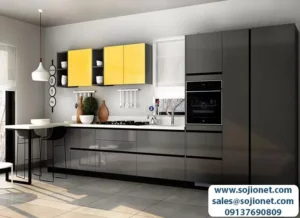
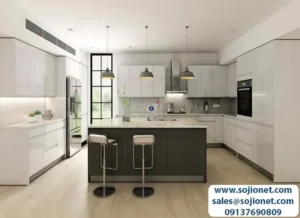
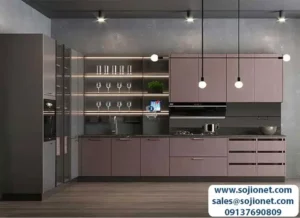
What are the Types of Woods Used for making Kitchen Cabinet?
- High Density Fiberboard (HDF) : This is made by layering thin sheets of wood veneer together with adhesive and pressing them into a single panel. HDF is strong, durable, and resistant to warping, making it a popular choice for cabinet
- Particleboard: This is made from small wood particles and chips that are compressed and bonded together with a resin binder. Particleboard is generally less expensive than MDF and is often used as a substrate for laminate or veneer finishes
- Medium-density fiberboard (MDF): This is a type of board made by breaking down hardwood or softwood residuals into wood fibers, combining them with wax and a resin binder, and forming panels by applying high temperature and pressure. MDF is an ideal material for cabinet construction as it is dense, strong, and uniform in density and thickness, and it can be machined easily.
- Hardboard: This is made from wood fibers that have been steamed and pressed into a dense, smooth panel. Hardboard is typically used as a substrate for laminate or veneer finishes, but it can also be used for cabinet construction.
- Oriented strand board (OSB): This is made from wood strands that are bonded together with resin and compressed under high pressure. OSB is strong and durable, and it is often used as a substrate for laminate or veneer finishes.
Though HDF and MDF are both types of engineered wood products, they are different. They are both made from wood fibers that are combined with resin and other materials to create a dense, stable panel. However, HDF is far stronger than MDF.
What is the Best Wood for making Kitchen Cabinet?
High Density Fiberboard (HDF) is The best wood. It comes as Matte HDF or High Gloss HDF.
Matte HDF is the normal form of HDF that is not shiny while High Gloss HDF ( also called Glossy HDF) is the shiny form.
Engineered boards are made by binding wood fibers, strands, or veneers together using adhesives and heat. These boards offer a number of benefits over solid wood, including greater stability, durability, and uniformity of grain and color. There are several types of engineered boards that are commonly used in the construction of kitchen cabinets, including:
When choosing an engineered board for kitchen cabinet construction, it is important to consider factors such as strength, durability, and resistance to moisture and humidity. MDF and particleboard (MFC) are more susceptible to moisture damage than HDF, so they may not be the best choice for areas such as kitchens and bathrooms. Furthermore, HDF (Matte or Glossy) is stronger and more durable than the other types of engineered boards, making it a better choice for heavy-duty applications such as cabinet construction.
How to calculate the number of HDF boards needed?
- Determine the dimensions of the cabinet Measure the height, width, and depth of the cabinet. This will help determine the amount of material needed for each panel of the cabinet.
- Choose the thickness of the HDF board HDF boards come in various thicknesses, ranging from 2.5mm to 25mm. The thickness you choose will depend on the size and weight of the cabinet, as well as your budget.
- Calculate the surface area of each panel To calculate the surface area of each panel, multiply the height by the width. For example, if the cabinet door is 50cm wide and 60cm high, the surface area would be 0.3 square meters (50cm x 60cm = 0.3m²).
- Account for cutting efficiency The cutting efficiency of the HDF board will affect the amount of waste generated during the cutting process. This should be factored into the calculation to ensure you have enough material to complete the project.
- Calculate the number of HDF boards needed Divide the total surface area of the cabinet by the surface area of each panel of the HDF board. For example, if the total surface area of the cabinet is 3 square meters and the HDF board has a surface area of 1 square meter per board, you would need three HDF boards.
Here’s an example on how to calculate Cost of Kitchen Cabinet
- Dimensions: The cabinet measures 80cm high, 60cm wide, and 40cm deep.
- HDF Board Thickness: The HDF board thickness is 16mm.
- Surface Area: The surface area of each panel is (0.8m x 0.6m) = 0.48m².
- Cutting Efficiency: Assume 10% cutting efficiency, meaning you will need 10% more material to account for waste generated during the cutting process.
- Number of HDF Boards: Total surface area of the cabinet = 2 x (0.8m x 0.6m) + 2 x (0.6m x 0.4m) = 1.92m². Including the 10% cutting efficiency, the total surface area needed will be 2.112m². Dividing by the surface area of each panel of HDF board (1.0m²), the number of HDF boards needed is 3.
Therefore, for this example, you would need 3 HDF boards to make the kitchen cabinet. Keep in mind that the actual number of HDF boards needed may vary depending on the design and size of your specific kitchen cabinet. It’s always a good idea to add a little extra material to ensure you have enough to complete the project.

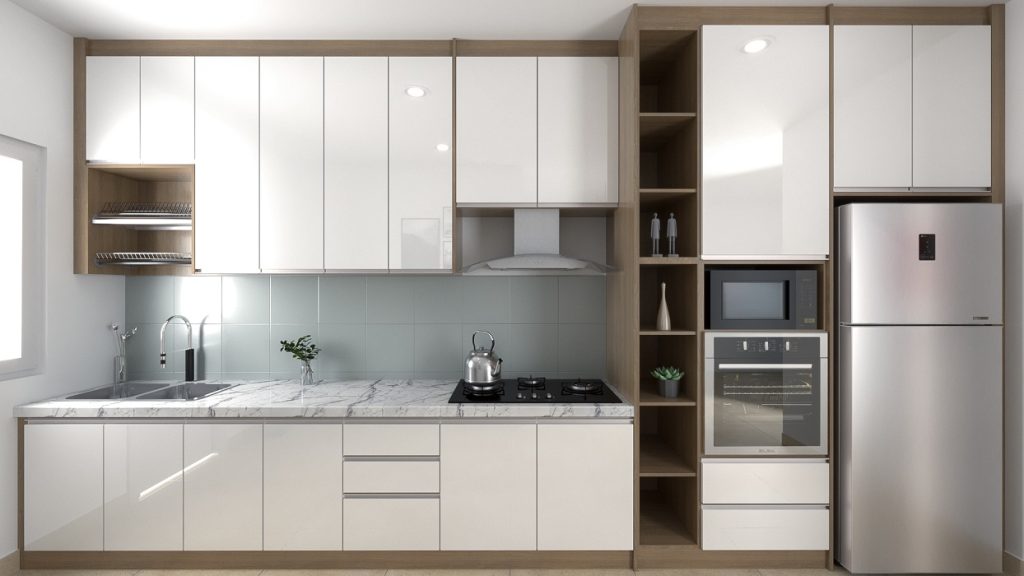

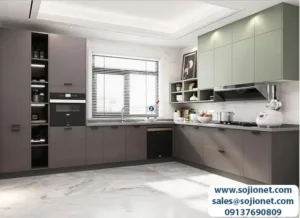
Very informative. Thanks for the support.